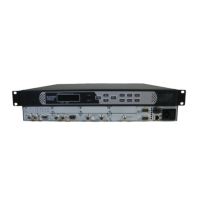VSB/QAM Receiver Option
This card will receive a TS that is demodulated from an 8 VSB signal or it will
demodulate a QAM 64B or QAM 256B RF input. With an 8 VSB input, the card will
tune to channels 2 – 69. With a QAM input, the card will tune to channels 2 – 134 in
three cable frequency bands (FCC, IRC, and HRC). The D9887B receiver will show a
valid input if the following conditions are met: the receiver equalizer and the FEC
are locked. If the RF level is lower than the "Low Warning Setting" or the MER is
lower than the "Low MER Warning Setting," the red "Error" LED will illuminate on
the front panel and there will be an error recorded in the Error List.
Serial Transport Stream I/O (DVB-ASI/SMPTE 310M) Option
This card will receive a TS from either a DVB-ASI input or a SMPTE-310M input.
Only one format may be selected at a time. For an ASI input, the bitrate of the TS
must be between 1.5 Mb/s and 160 Mb/s. For a SMPTE-310M input, the bitrate of
the TS must be 19.392658 Mb/s. The selected input format will also be the output
format. It can also be used as a TS output for any of the other input cards.
Video Output (1 RGBHV/YPbPr, 1 Composite) Option
An analog only video output card that can output either high definition or standard
definition formats. Two outputs are on the card: one BNC for composite (NTSC &
PAL) and one 15-pin D-sub for component (RGBHV or YPbPr). The card outputs an
SD or HD signal, one at a time. Closed caption (NTSC), detected in the transport
stream, can be inserted on line 21 of the composite (NTSC video) output.
Audio Output (Dolby E, AES Digital, Analog) Option
This card allows the output of both Digital-AES and analog audio. Each digital audio
output can be set to either Raw or PCM. In Raw, the compressed audio for the
selected PID is passed through to the digital output. Typically, this setting is used to
pass-through the Dolby AC-3 compressed digital signal. When the digital audio
output is set to PCM, two-channel linear coded PCM AES/EBU audio is output to
the digital output. The analog output provides two-channel (L, R) decoded analog
audio from the selected audio processor. The two audio processors on the decoder
board, feeding the two digital outputs, can process or decode Dolby AC-3, MPEG
Layer 1, or MPEG Layer 2 formats. The audio processor will self-sense which type of
audio is in the TS. It also has a Dolby E parsing feature.

